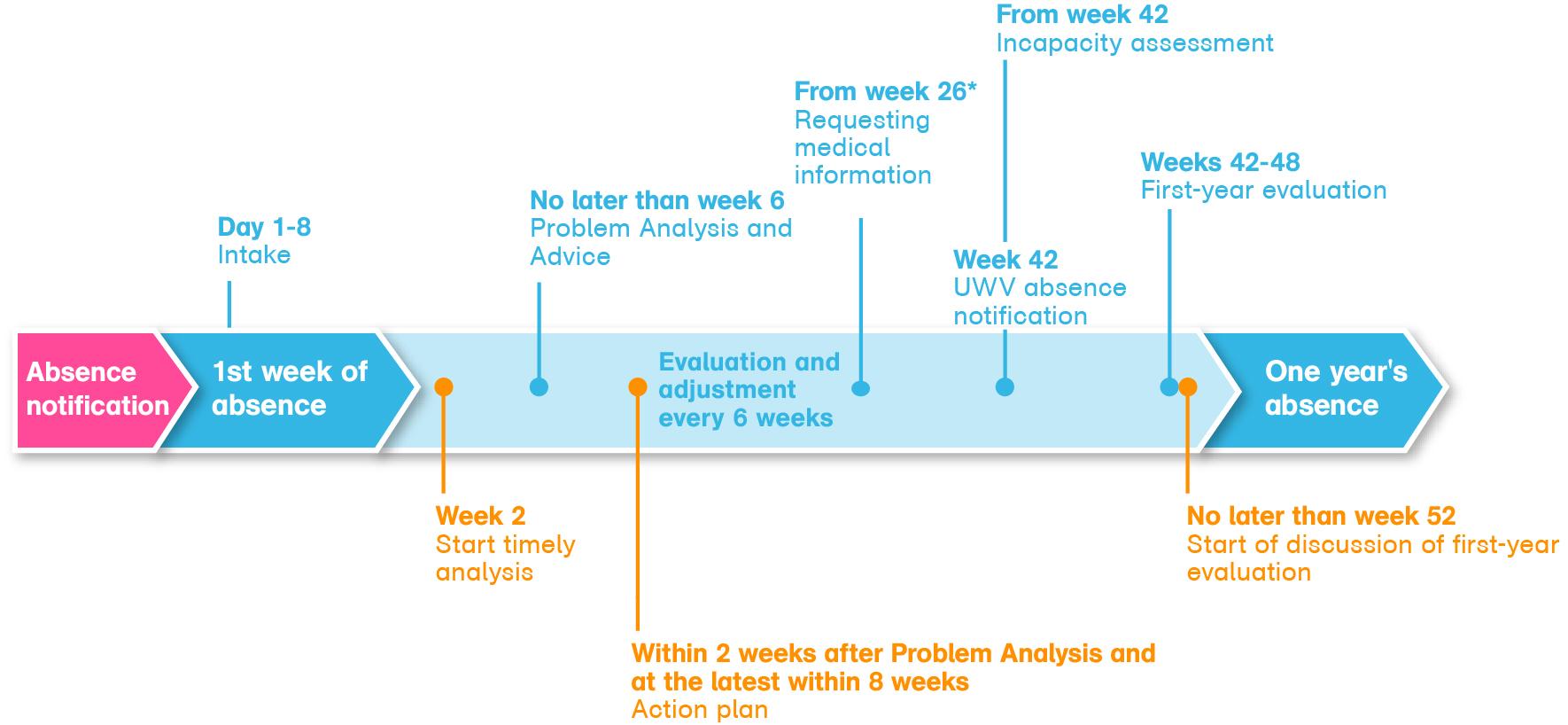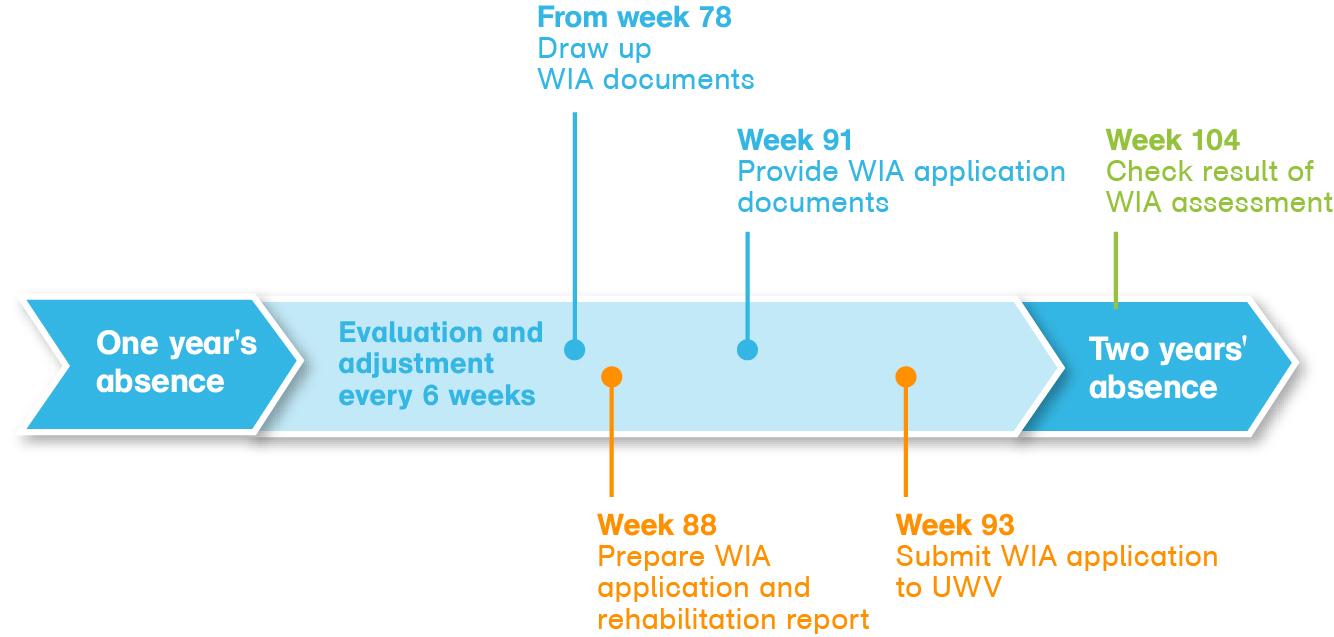The Eligibility for Permanent Incapacity Benefit (Restrictions) Act
In Dutch: Wet verbetering poortwachter.
The Eligibility for Permanent Incapacity Benefit (Restrictions) Act states that the employer and the employee are jointly responsible for the rehabilitation of a sick employee. Under this Act, the employer bears final responsibility and the employee is partly responsible for their own rehabilitation process. The aim is to enable the employee to return to work as quickly and as fully as possible through a timely and correct approach.

Comply with the Eligibility for Permanent Incapacity Benefit (Restrictions) Act?
An ArboNed absence management subscription guarantees compliance with the Eligibility for Permanent Incapacity Benefit (Restrictions) Act. Check which subscription best suits your company.
Continued salary payment
As an employer, you are obliged to continue paying your sick employee at least 70% of their last-earned salary for two years. If you are unable to demonstrate that you have made sufficient efforts to have your employee rehabilitate in accordance with the obligations under the Eligibility for Permanent Incapacity Benefit (Restrictions) Act, you may be obliged to continue paying salary in the third year as well.
Obligations under the Eligibility for Permanent Incapacity Benefit (Restrictions) Act
Employers and employees have various statutory obligations, which commence as early as the week of the sickness notification, also referred to as 'absence notification'.
Year 1

* Or as much earlier as necessary. The company doctor will assess this
Year 2

- Blue: Efforts of ArboNed
- Orange: Efforts of employer and employee
- Green: Efforts of UWV
Day 1: Request leave of absence
Your employee reports sick in accordance with the absence protocol. As an employer, you must pass on this sickness notification to the occupational health and safety service. At ArboNed we work with the online absence system Vandaag, enabling employers to report absence quickly and easily. You can also follow the status of the employee's absence in Vandaag.
Week 6: Problem analysis
Under the Eligibility for Permanent Incapacity Benefit (Restrictions) Act, the Problem Analysis must be drawn up in the sixth week of absence at the latest. The company doctor draws up a Problem Analysis based on the consultation, in which they describe things such as the limitations and possibilities of your employee. The analysis estimates the chances of return to work, outlines bottlenecks and the solutions. The company doctor also gives directional advice. This Problem Analysis forms the basis for the Action Plan.
Based on this analysis and the Action Plan (see next paragraph), UWV will assess whether the employer and employee have made sufficient efforts for a return to work. Due to privacy legislation, the employer does not receive any substantive and/or medical information about the interview. If you do not manage to draw up an Action Plan together, you can request an expert opinion from UWV.
Week 8: Action plan
Based on the Problem Analysis and the advice from the company doctor, you and your employee draw up the Action Plan, in which you lay down arrangements about the goal of the rehabilitation and the means by which this goal can best be achieved. Describe what (activity) you or your employee (who) will do starting when (planning). And appoint a case manager together who will supervise and monitor the Action Plan, preferably someone who also works for you. In most cases, the manager of the sick employee fulfils this role.
You and your employee will draw up the Action Plan no later than two weeks after receiving the Problem Analysis and advice. But there is more. The Action Plan is a snapshot, so you will meet at least once every six weeks to discuss progress. If necessary, you adjust the plan, on the advice of the company doctor or otherwise. As an employer, you ensure that the company doctor has regular contact with the employee about the progress of the incapacity for work.
Week 42: Absence notification to UWV
If you are a client of ours, ArboNed will pass on the absence notification to UWV.
Week 52: First-year evaluation
If your employee has been ill for almost a year, you and your employee fill in UWV's (first year) evaluation. ArboNed schedules a consultation with the (company) doctor for clients before the (first year) evaluation.
Week 87: Rehabilitation report
If your employee has not returned to work (in full) after 91 weeks, you must provide a rehabilitation report in order to apply for WIA benefit. In this report, the company doctor, employer and employee describe their views on the rehabilitation. In week 87, your employee will receive the WIA application forms from UWV. The company doctor describes the (medical) findings concerning the absence period – naturally in compliance with privacy laws – and gives their opinion on the situation.
Week 93: WIA review
On the basis of the rehabilitation report, UWV assesses whether the employer and the employee have done everything in their power to prevent the employee from having to apply for WIA benefit. UWV also invites your employee to a WIA examination.
If UWV finds that your employee has put insufficient effort into their rehabilitation, they may be refused benefit. If UWV believes that you as an employer have not cooperated enough in the rehabilitation, you will incur a penalty.
ArboNed absence management process
Download the PDF for a clear list of all the steps in the ArboNed absence management process. Of course it complies with the obligations under the Eligibility for Permanent Incapacity Benefit (Restrictions) Act.
More information
Are you looking for more depth? Then check out this informative article:
How does the Eligibility for Permanent Incapacity Benefit (Restrictions) Act work?